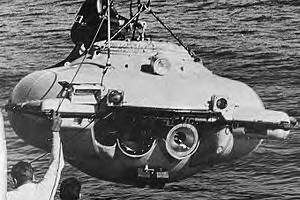| The SP-350 Denise, famous as the "Diving saucer"
(Soucoupe plongeante), is a small submarine designed to hold two people,
and is capable of exploring depths of up to 400 metres (1,300 ft). It was
invented by Jacques-Yves Cousteau and engineer Jean Mollard at the French
Centre for Undersea Research.
Its propulsion consists of steerable, electrically
powered water jets, allowing it to navigate in all directions, as well
as turn about its vertical axis. The crew members enter the craft through
a hatch on the top of the hull and lie prone side-by-side on mattresses
to operate it, watching their surroundings through tilted portholes that
let them come within a few centimeters of their subject. Electric lamps
are fitted for night diving and to provide illumination for photography
at extreme working depths. An electrically operated manipulator arm can
be fitted at the front of the craft so that objects can be picked up and
examined through the portholes.
The steel pressure hull, nearly circular in plan
form, is 2 metres (6 ft 7 in) in diameter and 1.43 metres (4 ft 8 in) high,
able to resist a pressure of more than 90 kg/cm2 (1,300 psi), equivalent
to a depth of nearly 900 metres (3,000 ft), although dives never exceed
300 metres (980 ft) for safety.
Despite having positive buoyancy, Denise is weighted
to negative |

| Name: |
SP-350 Denise |
| |
|
| Complement: |
2 |
| Displacement: |
3.8 tonnes |
| Length: |
2.75 m (9 ft) |
| Beam: |
2,75 m (9 ft) |
| Propulsion: |
Electric water jet |
| Speed: |
1 knot |
| Endurance: |
96 hours (one person) |
| Test depth: |
1,000 m (3,300 ft) |
|
|